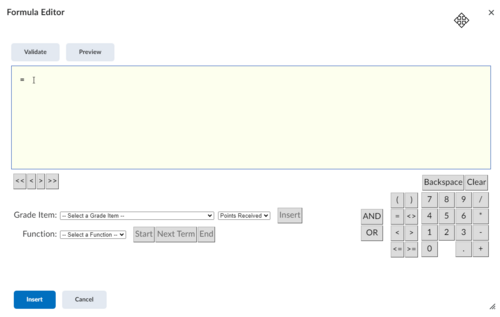Create a formula grade item
Formula grade items use already-existing items to create a new grade item in the grade book. Formulas can include several calculations, including things like adding up grades, finding the maximum minimum from a set of grades, averaging scores, and so on. Existing grade items are selected from a list of all available grade items in the grade book.
Formulas cannot be associated with assignments, discussions, or quizzes.
Creating formula grade items
- Start at the Manage Grades page in Grades.
- Select a New grade Item.
- Select a Formula grade.
- Name the new grade item.
- Select the grade items to be included by checking the boxes to the left of each item.
- Save and Close.
- In the General area, enter the name of your grade item. If you wish to use a shorter name as the column heading for this grade item, enter the Short Name.
- In the Grading area, enter the Maximum Points for the grade item.
- To define the formula for your grade item, click the Edit Using the Formula Editor link. In the Formula Editor window, enter your formula and click Insert. There is additional detail on creating formulas below.
- If you want users' grades to be able to exceed the maximum points specified for the item, select the Can Exceed check box.
- From the Grade Scheme drop-down list, select a grading scheme for your grade item.
- To attach a rubric to the grade item, click Add Rubric.
- In the Display Options area, do any of the following:
- Under Student View:
- To allow users to see the class average on the item, select the Display class average to users checkbox.
- To allow users to see a graph showing how grades are distributed between different percentiles, select the Display grade distribution to users checkbox.
- To allow graded users to view grade information for this item differently from other items in the grade book, select the Override display options for this item checkbox.
- Select Points, Grade scheme symbol, or Grade scheme color.
- Under Managing View:
- To view grade information for this item differently from other items in your grade book, select the Override display options for this item check box.
- Select either Points, Grade scheme symbol, or Grade scheme color.
- Under Student View:
- To associate a learning objective with the grade item, click the Objectives tab, and then Associate Learning Objectives.
- Click Save and Close.
Using the formula editor
Use the Formula Editor to define a formula that calculates a grade item’s value based on other grade items. When you create a formula, you specify which grade items you want included in the formula and the relationships between them. An example of a simple formula calculates the sum of a number of grade items. A more complicated formula drops the minimum or maximum value from a set of grade items.
| Component | Description |
|---|---|
| Formula area | The formula area is where the formula text displays. The equals sign (=) at the start of the formula cannot be deleted. A cursor shows your position in the formula. |
| Cursor placement | Use the cursor placement icons to move the cursor forwards and backwards in the formula. You can also move the cursor by clicking on the new location with your mouse. There are four options:
|
| Grade item parameters | To view what grade items you can insert as a parameter in your formula, use the Grade Item drop-down list. You can insert Numeric, Pass/Fail, Selectbox, and Formulatype grade items. You cannot reference the formula grade item you are defining or a final grade.
To view the values associated with the grade item you want to use in the formula, use the Grade Item Value drop-down list. There are three options:
When using the weighted system, category and grade item weights are ignored in formula calculations. Dropped grade items and bonus grade items are calculated the same as other grade items. |
| Functions | The Function drop-down list contains a list of functions that you can use in your calculation formula:
You can embed functions within functions. The Start, Next Term, and End options are used to define elements of a function:
|
| Operators | Operators are usually used in conjunction with at least one grade item. |
The information describing the Formula Editor comes from Creating grade items from the Brightspace support site.
More information
- Creating grade items from the Brightspace support site
- Grades from the Brightspace support site
- Managing grades and grade items from the Brightspace support site
